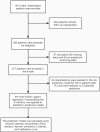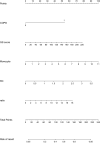A Nomogram for Predicting In-Stent Restenosis Risk in Patients Undergoing Percutaneous Coronary Intervention: A Population-Based Analysis
- PMID: 35264881
- PMCID: PMC8901259
- DOI: 10.2147/IJGM.S357250
A Nomogram for Predicting In-Stent Restenosis Risk in Patients Undergoing Percutaneous Coronary Intervention: A Population-Based Analysis
Abstract
Objective: In-stent restenosis (ISR) is a fatal complication of percutaneous coronary intervention (PCI). An early predictive model with the medical history of patients, angiographic characteristics, inflammatory indicators and blood biochemical index is urgently needed to predict ISR events. We aim to establish a risk prediction model for ISR in CAD patients undergoing PCI.
Methods: A total of 477 CAD patients who underwent PCI with DES (drug-eluting stents) between January 2017 and December 2020 were retrospectively enrolled. And the preoperative factors were compared between the non-ISR and ISR groups. The least absolute shrinkage and selection operator (LASSO) and multi-factor logistic regression were used for statistical analysis. The prediction model was evaluated using receiver operator characteristic (ROC) analysis, the Hosmer-Lemeshow 2 statistic, and the calibration curve.
Results: In this study, 94 patients developed ISR after PCI. Univariate analysis showed that post-PCI ISR was associated with the underlying disease (COPD), higher Gensini score (GS score), higher LDL-C, higher neutrophil/lymphocyte ratio, and higher remnant cholesterol (RC). The multi-factor logistic regression analysis suggested that remnant cholesterol (odds ratio [OR] = 2.09, 95% confidence interval [CI] [1.40-3.11], P < 0.001), GS score (OR = 1.01, 95% CI [1.00, 1.02], P = 0.002), medical history of COPD (OR = 4.56, 95% CI [1.98, 10.40], P < 0.001), and monocyte (OR = 1.30, 95% CI [1.04, 1.70], P < 0.001) were independent risk factors for ISR. A nomogram was generated and displayed favorable fitting (Hosmer-Lemeshow test P = 0.609), discrimination (area under ROC curve was 0.847), and clinical usefulness by decision curve analysis.
Conclusion: Patients with certain preoperative characteristics, such as a history of COPD, higher GS scores, higher levels of RC, and monocytes, who undergo PCI may have a higher risk of developing ISR. The predictive nomogram, based on the above predictors, can be used to help identify patients who are at a higher risk of ISR early on, with a view to provide post-PCI health management for patients.
Keywords: CHD; ISR; PCI; coronary heart disease; in-stent restenosis; nomogram map; percutaneous coronary intervention.
© 2022 Luo et al.
Conflict of interest statement
Yinhua Luo and Ni Tan are co-first authors for this study. The authors report no conflicts of interest in this work.
Figures






Similar articles
-
Risk prediction model for in-stent restenosis following PCI: a systematic review.Front Cardiovasc Med. 2024 Aug 29;11:1445076. doi: 10.3389/fcvm.2024.1445076. eCollection 2024. Front Cardiovasc Med. 2024. PMID: 39267809 Free PMC article.
-
Development and validation of a risk prediction nomogram for in-stent restenosis in patients undergoing percutaneous coronary intervention.BMC Cardiovasc Disord. 2021 Sep 14;21(1):435. doi: 10.1186/s12872-021-02255-4. BMC Cardiovasc Disord. 2021. PMID: 34521385 Free PMC article.
-
A prediction model based on platelet parameters, lipid levels, and angiographic characteristics to predict in-stent restenosis in coronary artery disease patients implanted with drug-eluting stents.Lipids Health Dis. 2021 Sep 29;20(1):118. doi: 10.1186/s12944-021-01553-2. Lipids Health Dis. 2021. PMID: 34587955 Free PMC article.
-
A risk score for predicting in-stent restenosis in patients with premature acute myocardial infarction undergoing percutaneous coronary intervention with drug-eluting stent.Heliyon. 2024 Jul 4;10(13):e34077. doi: 10.1016/j.heliyon.2024.e34077. eCollection 2024 Jul 15. Heliyon. 2024. PMID: 39055837 Free PMC article.
-
Pre-Percutaneous Coronary Intervention C-Reactive Protein Levels and In-Stent Restenosis: A Systematic Review and Meta-Analysis.Health Sci Rep. 2025 Apr 29;8(5):e70757. doi: 10.1002/hsr2.70757. eCollection 2025 May. Health Sci Rep. 2025. PMID: 40309624 Free PMC article. Review.
Cited by
-
A systematic review of clinical and biomechanical engineering perspectives on the prediction of restenosis in coronary and peripheral arteries.JVS Vasc Sci. 2023 Sep 15;4:100128. doi: 10.1016/j.jvssci.2023.100128. eCollection 2023. JVS Vasc Sci. 2023. PMID: 38023962 Free PMC article. Review.
-
A systematic review and bioinformatic study on clinical, paraclinical, and genetic factors predisposing to stent restenosis following percutaneous coronary intervention.BMC Cardiovasc Disord. 2024 Jun 14;24(1):304. doi: 10.1186/s12872-024-03955-3. BMC Cardiovasc Disord. 2024. PMID: 38877398 Free PMC article.
-
Impact of risk factors on intervened and non-intervened coronary lesions.Am J Cardiovasc Dis. 2024 Aug 25;14(4):255-266. doi: 10.62347/XTBG3549. eCollection 2024. Am J Cardiovasc Dis. 2024. PMID: 39309112 Free PMC article.
-
Risk prediction model for in-stent restenosis following PCI: a systematic review.Front Cardiovasc Med. 2024 Aug 29;11:1445076. doi: 10.3389/fcvm.2024.1445076. eCollection 2024. Front Cardiovasc Med. 2024. PMID: 39267809 Free PMC article.
-
A 2024 scientific update on the clinical performance of drug-coated balloons.AsiaIntervention. 2024 Feb 29;10(1):15-25. doi: 10.4244/AIJ-D-23-00010. eCollection 2024 Feb. AsiaIntervention. 2024. PMID: 38425817 Free PMC article. Review.
References
-
- Gai M-T, Zhu B, Chen X-C, et al. A prediction model based on platelet parameters, lipid levels, and angiographic characteristics to predict in-stent restenosis in coronary artery disease patients implanted with drug-eluting stents. Lipids Health Dis. 2021;20(1):118. doi:10.1186/s12944-021-01553-2 - DOI - PMC - PubMed
LinkOut - more resources
Full Text Sources
Miscellaneous

